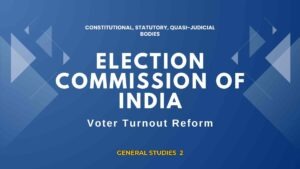Election Commission of India - Important Notes for UPSC
Election Commission of India
📘 Constitutional Provisions
Article 324 of the Indian Constitution provides for:
Superintendence, direction, and control of elections to the Parliament, State Legislatures, and the offices of the President and Vice-President of India.
📜 Scope:
Lok Sabha & Rajya Sabha
State Legislative Assemblies & Councils
President & Vice-President
👥 Composition of the ECI
| Component | Details |
|---|---|
| Initially | One Chief Election Commissioner (CEC) (1950–1989) |
| Post-1989 | Multi-member Commission (1 CEC + 2 Election Commissioners) |
| Current Composition | CEC + 2 Election Commissioners (Equal powers) |
| Appointment | By the President of India |
| Tenure | 6 years or up to age 65, whichever is earlier |
| Removal (CEC) | Like a Supreme Court judge (via Parliament impeachment) |
| Removal (ECs) | On CEC’s recommendation by the President |
🧰 Powers and Functions
📊 Electoral Functions
Prepare and revise electoral rolls.
Conduct free and fair elections.
Monitor model code of conduct.
Grant recognition to political parties and allot symbols.
Declare poll results and disqualify candidates if necessary.
📝 Advisory Functions
Advise the President on disqualifications (Article 103).
Advise Governors on disqualifications (Article 192).
🧑⚖️ Quasi-Judicial Powers
Decide disputes related to party recognition and symbol allocation.
Power to cancel elections due to malpractices (under Article 324).
💡 Important Articles & Provisions
| Article | Provision |
|---|---|
| 324 | Superintendence, direction, control of elections |
| 325 | One general electoral roll for every constituency |
| 326 | Adult suffrage (18 years and above) |
| 327 | Parliament power to make laws for elections |
| 328 | State Legislature’s power for state elections |
| 329 | Bar on interference by courts in electoral matters |
⚖️ Recent Reforms and Issues
✅ Reforms
ECINET App: Real-time voter turnout reporting.
VVPAT Machines: Added transparency to EVMs.
cVIGIL App: Citizens report model code violations.
Know Your Candidate: Mandatory disclosure of criminal records.
❗ Issues and Challenges
Lack of a statutory framework to ensure ECI’s independence.
Appointment mechanism criticized for executive dominance.
Lack of financial autonomy (dependent on executive budgetary approvals).
Delayed action on model code violations.
No power to de-register political parties.
🏛️ Important Supreme Court Judgments
| Case | Significance |
|---|---|
| Mohinder Singh Gill (1978) | Election Commission’s role is not just administrative, but adjudicatory and quasi-judicial. |
| S.S. Dhanoa Case (1991) | Upheld ECI’s independence; CEC enjoys protection equal to SC judges. |
| 2023 SC Judgment | Directed that CEC and ECs must be appointed by a panel comprising PM, LoP, and CJI (to enhance independence). |
🧠 Relevance for UPSC
🔹 Prelims Pointers
Article 324–329
Powers of ECI
Composition & tenure
VVPAT, ECINET, cVIGIL, NOTA
Election Commission of India – Voter Turnout Reform
📍 In News
The Election Commission of India (ECI) has launched a tech-driven voter turnout reporting system via the ECINET app, aiming for real-time polling data updates and enhanced transparency in electoral processes.
🧰 About the Reform
✅ What is the Reform?
A new real-time voter turnout reporting system through the ECINET mobile application.
Aims to:
Eliminate manual relay delays in voter turnout data.
Strengthen public trust and institutional transparency.
Enable real-time monitoring of polling activity across constituencies.
📱 ECINET App:
Integrated mobile platform of the ECI consolidating 40+ internal apps and platforms.
Used by Presiding Officers at polling booths to:
Update voter turnout every 2 hours.
Upload data offline (syncs automatically in network zones).
Ensures coverage even in low-network or remote areas.
🔍 Key Features of the New System
Direct Entry: Presiding officers enter turnout data directly into ECINET; bypasses sector and returning officers.
Automatic Aggregation: Data compiled and reflected at constituency level almost immediately.
Real-Time Trends: Approximate voter turnout displayed soon after polling ends, depending on connectivity.
Reduced Lag: Replaces past delays (from hours/days) with near real-time updates.
Minimized Errors: Digital entry eliminates manual tabulation mistakes and reporting inconsistencies.
🏛️ Significance for Governance and Democratic Process
1. Electoral Transparency
Addresses suspicions of data manipulation during vote counting and reporting.
Enhances public trust in the fairness and neutrality of the ECI.
2. E-Governance and Digital India
Aligned with the broader Digital India and e-Governance initiatives.
Promotes data-driven decision-making and digital monitoring of elections.
3. Trust in Institutions
Bolsters credibility of the ECI as a constitutional body.
Reinforces India’s commitment to free, fair, and transparent elections.
4. Operational Efficiency
Reduces dependence on human relay systems.
Faster dissemination of official data to stakeholders including media, political parties, and civil society.
📘 Additional Points for UPSC
🏛️ About the Election Commission of India (ECI):
Constitutional Body under Article 324 of the Indian Constitution.
Responsible for conducting elections to:
Lok Sabha
Rajya Sabha
State Legislative Assemblies and Councils
Offices of the President and Vice President
Autonomous and independent, with powers to supervise, direct, and control the entire election process.
🧠 Relevance for UPSC Exam
🔹 Prelims Focus Areas:
ECINET App
Article 324
Constitutional powers of ECI
E-governance in elections
Use of technology in elections
🔹 Mains GS Paper II (Polity & Governance):
Question Example:
“Discuss how the Election Commission of India’s recent voter turnout reporting reforms reflect the principles of transparency, accountability, and good governance.”
Answer Pointers:
Mention the ECINET App and its features.
Link to transparency, reduced manual errors, faster public access.
Discuss alignment with e-Governance goals.
Conclude with implications for strengthening democratic institutions.
🧾 Conclusion
The ECI’s voter turnout reform via the ECINET app marks a paradigm shift in electoral transparency and efficiency. It is not only a technological innovation but also a democratic necessity in today’s data-driven governance environment, crucial for ensuring voter confidence and institutional integrity in the world’s largest democracy.
Mains-Based Questions on Election Commission of India
✅ Q1. Examine the role of the Election Commission of India in ensuring free and fair elections. How have recent technological reforms like the ECINET app contributed to electoral transparency?
📝 Answer Framework:
Introduction:
Briefly introduce the Election Commission of India as a constitutional body under Article 324 tasked with conducting free and fair elections.
Mention the increasing role of technology in electoral processes.
Body:
I. Role of ECI in Ensuring Free and Fair Elections:
Supervision of elections to Parliament, State Assemblies, and high offices.
Model Code of Conduct enforcement.
Voter roll management.
Recognizing political parties and symbols.
Ensuring level playing field through expenditure limits and campaign regulations.
II. Challenges to Free and Fair Elections:
Allegations of partiality.
Delayed action on Model Code violations.
Lack of power to deregister political parties.
Issues of fake news and voter manipulation.
III. Technological Reforms – ECINET App:
Real-time voter turnout reporting from polling booths.
Direct entry by presiding officers eliminates manual delays.
Enables automatic constituency-level data aggregation.
Reduces scope for manipulation and builds public trust.
Offline data entry supports remote polling stations.
IV. Significance of the Reform:
Aligns with e-Governance and Digital India.
Increases transparency and accountability.
Responds to citizens’ demands for quicker and trustworthy electoral data.
Conclusion:
While ECI has made significant strides using technology like ECINET, further institutional and legal reforms (e.g., transparent appointment, financial autonomy) are needed to enhance its effectiveness and credibility.
✅ Q2. The Election Commission of India is a robust constitutional body, yet it faces challenges in maintaining its independence and credibility. Discuss with reference to recent reforms such as the ECINET app.
📝 Answer Framework:
Introduction:
Define ECI and its mandate under Article 324.
Mention its vital role in sustaining India’s democratic structure.
Body:
I. Strengths of ECI:
Autonomous constitutional body.
Extensive powers during the conduct of elections.
Historical record of conducting peaceful elections at a massive scale.
II. Challenges to Independence and Credibility:
Appointment process lacks transparency (Executive dominance).
No independent secretariat; dependent on govt for funds.
No statutory power to penalize or deregister political parties.
Perception of bias in some recent elections.
III. Recent Reforms – ECINET App:
Introduced to improve transparency in reporting voter turnout.
Allows real-time updates from presiding officers.
Reduces delays and data manipulation.
Boosts credibility and public confidence.
Complements other digital tools like cVIGIL, VVPAT, and Know Your Candidate.
IV. Limitations of Technological Solutions Alone:
Cannot replace deeper structural reforms.
Need for an impartial and independent appointment process.
Financial and administrative independence essential.
Conclusion:
ECI’s credibility must rest not just on technology but on legal and structural reforms that uphold its constitutional status. The ECINET app is a welcome step but must be complemented with broader systemic changes.
✅ Q3. Critically analyze the use of technology by the Election Commission of India in electoral processes. How does it address the concerns of transparency, efficiency, and trust in the electoral system?
📝 Answer Framework:
Introduction:
Highlight the increasing role of technology in India’s electoral process.
Mention the ECI’s adoption of innovations like EVMs, VVPAT, cVIGIL, and ECINET.
Body:
I. Technological Tools Used by ECI:
Electronic Voting Machines (EVMs) – Reduce manual vote counting errors.
VVPATs – Enhances verifiability and transparency.
cVIGIL App – Empowers citizens to report violations.
ECINET App – Provides real-time voter turnout data.
Know Your Candidate Portal – Ensures informed voting.
II. Impact on Electoral Processes:
Increases efficiency in data management.
Reduces human error and delays.
Enhances transparency and voter confidence.
Improves complaint redressal mechanisms.
III. Concerns and Limitations:
Allegations of malfunction or mistrust in EVMs/VVPATs.
Digital divide: Not all stakeholders have equal access or training.
Connectivity issues in remote areas may hinder real-time updates.
Technology cannot fully compensate for institutional shortcomings.
Conclusion:
Technology is a powerful enabler but must be backed by robust legal frameworks, institutional reforms, and public outreach to truly enhance the integrity of India’s electoral democracy.
Prelims Questions based on Election Commission of India
-
Special Economic Zones Rules – Important UPSC Notes
The Government of India has recently relaxed certain provisions of... -
National Conference of Estimates Committees – Important UPSC Notes
Lok Sabha Speaker inaugurated the National Conference of Estimates Committees... -
Election Commission of India – Important UPSC Notes
The Election Commission of India (ECI) has launched a tech-driven... -
Banakacherla Reservoir Project – Important UPSC Notes
A fresh inter-state water dispute has arisen between Andhra Pradesh... -
India-Japan Maritime Relation – Important UPSC Notes
India and Japan have intensified bilateral maritime collaboration (India-Japan Maritime... -
UNESCO Global Education Monitoring (GEM) Report
The UNESCO Global Education Monitoring (GEM) Report 2024–25 highlights that... -
Registered Unrecognised Political Parties – Important UPSC Notes
The Election Commission of India (ECI) has initiated the delisting... -
Viksit Bharat Ka Amrit Kaal Report – Important UPSC Notes
Viksit Bharat Ka Amrit Kaal Report - Important Notes for...









